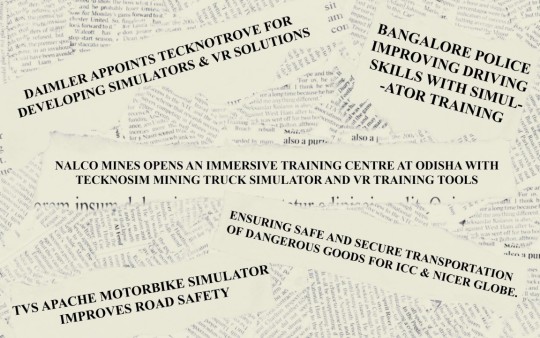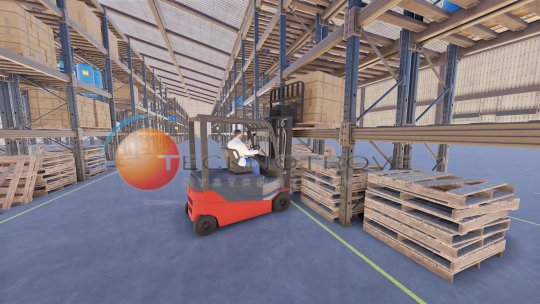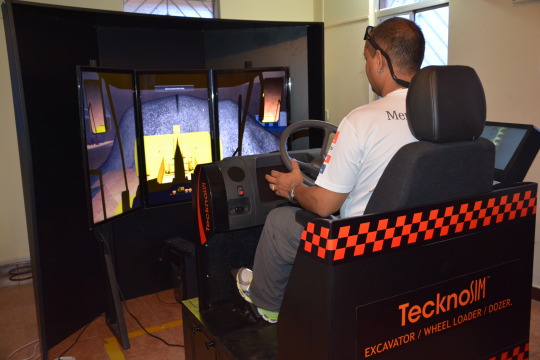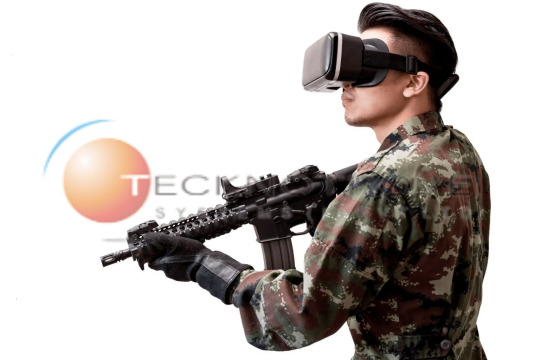Text
Revolutionizing Mining Truck Driver Training: The Power of Simulators
Introduction:
In the mining industry, safety and efficiency are of utmost importance, especially when it comes to operating heavy equipment such as mining trucks. With the advancements in technology, mining truck driver training simulators have emerged as a game-changer in preparing operators for real-world challenges. In this blog post, we will delve into the world of VR mining truck driver training simulators, exploring their benefits, features, and the impact they are making on the mining industry.
The Need for Effective Mining Truck Driver Training:
Discuss the risks and challenges associated with mining truck operations.
Highlight the importance of comprehensive training to ensure safety and efficiency.
Explain the limitations of traditional training methods and the need for innovative solutions.
Enter the Mining Truck Driver Training Simulator:
Introduce mining truck driver training simulators as a cutting-edge training tool.
Explore the features and capabilities of simulators designed specifically for mining trucks.
Discuss how simulators replicate real-world scenarios and provide a realistic training experience.
Advantages of Mining Truck Driver Training Simulators:
Enhanced safety: Explain how Mining simulators allow operators to learn and practice in a controlled environment, minimizing the * risk of accidents and injuries.
Cost-effectiveness: Discuss how simulators can reduce training costs by eliminating the need for real trucks, fuel, and maintenance.
Improved efficiency: Highlight how simulators enable operators to master skills, improve reaction times, and optimize their performance on the job.
Environmental impact: Discuss how simulator training reduces the carbon footprint by eliminating the need for real trucks and associated emissions.
Real-Time Monitoring and Feedback:
Explore the monitoring and feedback capabilities of mining truck driver training simulators.
Explain how trainers can track progress, identify areas for improvement, and provide targeted guidance.
Discuss the benefits of immediate feedback in enhancing learning outcomes and skill development.
Bridging the Gap between Training and Real-Life Situations:
Discuss the challenges faced by new mining truck operators when transitioning from simulators to real trucks.
Highlight strategies and approaches to bridge this gap effectively.
Explain the importance of continued training and support for operators to ensure a smooth transition.
The Future of Mining Truck Driver Training:
Explore emerging technologies such as virtual reality (VR) and augmented reality (AR) in mining truck driver training.
Discuss potential advancements and improvements that could further enhance simulator training.
Predict the impact of ongoing technological innovations on the mining industry and its workforce.
Conclusion:
Mining truck driver training simulators have revolutionized the way operators are trained, offering a safe, cost-effective, and efficient alternative to traditional training methods. As the mining industry continues to embrace technological advancements, simulators will play a crucial role in preparing operators for the challenges they will face on the job. By investing in comprehensive training programs that utilize these simulators, mining companies can ensure the safety, productivity, and success of their operations in the long run.

0 notes
Text
In Indian businesses, simulation-based training is becoming increasingly popular
In Indian businesses, VR simulation-based training is gaining significant popularity as a highly effective learning method. Traditionally, training in Indian businesses often involved classroom lectures, presentations, and on-the-job shadowing. However, the rapid advancements in technology and the increasing complexity of business environments have led to the adoption of simulation-based training.
Simulation-based training involves creating virtual environments or scenarios that closely resemble real-life business situations. Employees are then placed in these simulations, allowing them to interact with the virtual environment, make decisions, and experience the consequences of their actions. This Tecknotrove VR Training simulator solution provides a safe and controlled learning environment where employees can learn from their mistakes without any real-world repercussions.
One major advantage of simulation-based training is its ability to replicate complex and challenging business scenarios that may not occur frequently in real life. For instance, it can simulate crisis management situations, customer interactions, market fluctuations, and leadership challenges. This enables employees to develop critical thinking, problem-solving, and decision-making skills in a risk-free setting.
Another benefit of simulation-based training is its scalability and cost-effectiveness. With traditional training methods, organizing and conducting large-scale training programs can be time-consuming and expensive. Simulation-based training eliminates these limitations by allowing multiple employees to participate simultaneously, regardless of their physical location. It can be delivered through web-based platforms, virtual reality (VR) headsets, or computer simulations, reducing logistical constraints and overall training costs.
Furthermore, simulation-based training offers personalized learning experiences. It can be tailored to address specific skill gaps or job roles, ensuring that employees receive relevant and targeted training. Additionally, the immediate feedback provided by simulations allows participants to assess their performance, identify areas for improvement, and make necessary adjustments, leading to accelerated learning outcomes.
Indian businesses are recognizing the value of simulation-based training in developing a skilled and adaptable workforce. By incorporating this innovative approach, they are equipping employees with the necessary competencies to navigate complex business challenges and drive organizational growth. As technology continues to evolve, it is likely that simulation-based training will become an integral part of the Indian business landscape, enabling continuous learning and development for employees.

0 notes
Text
The Advantages of Using Virtual Reality Forklift Simulators in Logistics Training
Virtual Reality technology has revolutionized training in various industries, and logistics is no exception. One of the most promising applications of VR in logistics training is the use of virtual reality forklift simulators. These simulators allow trainees to practice operating forklifts in a safe and controlled environment, improving their skills and reducing the risk of accidents.
One of the advantages of using Virtual Reality forklift simulators is that they offer a highly immersive and engaging learning experience. Trainees can experience what it's like to operate a forklift without the risk of injury or damage to equipment. This experience can help them better understand the challenges and best practices associated with forklift operations.
Another advantage of VR forklift simulators is that they can help reduce training costs. Traditional forklift training requires access to a physical forklift and an instructor to oversee the training. In contrast, VR simulators require only a VR headset and controllers, making it a cost-effective solution.
Overall, virtual reality forklift simulators have the potential to transform logistics training by providing a safe, engaging, and cost-effective way for trainees to improve their forklift operation skills.

0 notes
Text

Top 5 Benefits of Using an Infantry Weapon Training Simulator in Defense Training
An infantry weapon training simulator is a valuable tool for defense training. It provides a safe and controlled environment for soldiers to practice their weapon handling and marksmanship skills. With advancements in technology, these military training simulators have become more realistic, allowing soldiers to train in various scenarios that they may encounter in real-world situations.
Some of the benefits of using an infantry weapon training simulator include:
Safety: Simulators provide a safe environment for soldiers to practice their weapon handling and marksmanship skills without the risk of injury or death.
Realistic scenarios: Simulators can recreate various real-world scenarios that soldiers may encounter in the field. This can help soldiers to better prepare for situations they may face in combat.
Cost-effective: Traditional training methods involving live ammunition can be expensive. Using simulators can significantly reduce the cost of training while still providing valuable training experiences.
Feedback: Simulators can provide instant feedback to soldiers on their performance. This feedback can help soldiers identify areas where they need improvement and work to improve their skills.
Repetition: Soldiers can repeat training scenarios as many times as needed in a simulator. This can help them to refine their skills and improve their performance.
Overall, an infantry weapon training simulator is a valuable tool for defense training. It provides soldiers with a safe and realistic environment to practice their skills, which can ultimately help to improve their performance in real-world situations.
0 notes
Text
Dump Truck Simulator one of the effective tool in Mining
Tecknotrove Dump truck simulator for mining are indeed an effective tool in the mining industry. They provide a realistic and safe environment for new or inexperienced drivers to learn and practice operating dump trucks before they are allowed to drive the real machines.
Simulators also offer a cost-effective VR training solution as they eliminate the need for actual equipment and resources that may be expensive to maintain or may not be available for training. This way, drivers can learn how to operate dump trucks without putting themselves or other personnel at risk, and without damaging equipment or the environment.
In addition, simulators can be used to train drivers on different scenarios and conditions, such as adverse weather, road hazards, or emergency situations, that may not be safe or feasible to recreate in real life. This helps drivers to develop their skills and confidence, and to be better prepared to handle challenging situations on the job.
Overall, dump truck simulators are an efficient and effective tool for mining companies to train their drivers, reduce the risk of accidents, and improve the safety and productivity of their operations.

0 notes
Text
Effectiveness of excavator simulator training in Mining
Excavator simulator training can be an effective way to train mining personnel in the operation of heavy equipment. Here are some reasons why:
Safe Training Environment: Excavator simulators in mining offer a safe training environment for trainees to learn and practice operating heavy equipment. This minimizes the risk of accidents and injuries that could occur in a real-life mining environment.
Cost-effective: Simulator training is cost-effective because it eliminates the need for fuel, maintenance, and wear and tear on the equipment. It also reduces the need for physical space, as simulators can be used indoors.
Realistic scenarios: Excavator simulators are designed to replicate real-life scenarios, giving trainees a chance to experience and learn from simulated situations that they may encounter in the field.
Efficient training: Simulator training can be more efficient than traditional training methods because it allows trainees to practice and repeat tasks until they have mastered them. This can save time and improve the effectiveness of training.
Enhanced skills: The use of excavator mining simulators can enhance the skills of mining personnel by providing a realistic training environment. Trainees can learn how to operate heavy equipment safely and effectively, and also learn how to troubleshoot and resolve problems that may arise during the operation.
Overall, excavator simulator training can be an effective way to train mining personnel in the operation of heavy equipment. It offers a safe, cost-effective, and realistic training environment that can enhance the skills of trainees and improve the effectiveness of training.

0 notes
Text
Use of VR Military Training Simulator in Defence Training
Virtual reality (VR) military training simulators can be a valuable tool in defence training. Here are some of the ways they can be used:
Realistic Combat Scenarios: VR training simulators can provide a realistic environment for soldiers to train in. This allows them to experience combat scenarios that would be difficult or impossible to simulate in real life.
Safe Environment: VR training simulators allow soldiers to train in a safe environment without risking injury. This can be especially important for training in dangerous situations such as handling explosives or conducting high-risk missions.
Repetition: With VR training simulators, soldiers can repeat scenarios until they have mastered the necessary skills. This helps to build muscle memory and improve reaction times, which are essential in combat situations.
Cost-Effective: VR training simulators can be more cost-effective than traditional training methods. They eliminate the need for expensive equipment and can be used repeatedly without additional costs.
Customizable: VR training simulators can be customized to meet specific training needs. They can be designed to simulate different environments, weapons, and scenarios to provide soldiers with the most effective training possible.
Overall, the use of VR military training simulators in defence training can provide soldiers with a safe and realistic environment to develop the skills necessary to succeed in combat situations.

0 notes
Text
Use of VR simulator in effective Training….
The use of simulators in training has proven to be highly effective in skilling and upskilling employees across a wide range of industries. When compared to traditional training methods, virtual training is not only four times faster, but also safer and more cost-effective in the long run. Simulations are immersive, engaging, and a powerful tool for imparting standardized training across departments around the world. Simulator Training is an effective tool in a virtual environment. It allows employees to make mistakes and learn from their mistakes in a safe, controlled environment without the risks and consequences of real-world failures. Additionally, employees across geographies can be trained effectively without compromising quality because the need for expensive real-world settings is eliminated. Moreover, simulators make it easy to replicate difficult situations in a Virtual Reality Simulation environment for training purposes that cannot be created in real life. It also allows standardized evaluation of actual skills in real-time, identifying training gaps and needs for further training.
In the aviation, automotive & logistics, mining & construction, and defense industries, simulator training has shown to be an effective tool for skill development and vocational training. Simulator-based training is hence the need of the hour. It provides a safe environment for training and effectively caters to the organization’s evolving needs to upskill, reskill, and cross-kill employees. Investing in training simulators and virtual reality for vocational training and skill development makes business sense.

0 notes
Text

Tecknotrove Motorcycle Driving Simulator in India
TecknoSIM Motorcycle Driving Simulator is designed to train and test motorcycle riders on actual road conditions. Riders gain real-life experience as training is conducted on realistic scenarios and road conditions under complete safety. The motorcycle simulator is a replica of a real bike with brake, clutch, accelerator, gear, and ignition key switch placed in ergonomically correct locations. During training, the rider gets exposed to various weather conditions, traffic density, different traffic scenarios, and real-life hazards under complete safety. The Tecknotrove motorcycle simulator is ideal to train novice as well as advanced riders.
0 notes
Text

APPLICATIONS OF VR IN ENTERPRISE OR INDUSTRIAL TRAINING:
Many industries have widely adopted virtual reality for various purposes. Virtual reality makes practical training sessions much easier and effective. Simply studying PDF material and trying to implement the learnings in real world scenarios would definitely produce poor results. Virtual reality can take enterprise and industrial training to a whole new level by upskilling employees at a much faster rate than traditional methods.
Here’s an overview of the applications of virtual reality in enterprise and Vr industrial training:
Recruitment and Onboarding:
VR training can be used to improve the recruitment and onboarding process within an organisation. Using VR , the candidates can be put in a realistic scenario and be interviewed virtually with relevant questions specific to the job role . VR can also help companies in onboarding employees. With the help of VR , companies can virtually induct employees to the process ,workflow and common challenges in a job.
Emergency Preparedness Training:
Another application of VR is preparing employees for emergency situations like fire,machine breakdown, incidents. Crisis situations are created not just to train employees to effectively deal with emergencies but gauge their stress levels while doing so. Employers can measure the performance of each employee and set individual goals. With virtual reality, it is possible to understand and improve the capabilities of employees and help them achieve goals faster. Organizations with virtual reality training can mould and transform employees into valuable resources aligned with their company culture.
General Safety training:
Employees with sharp decision making skills are indeed a valuable asset for companies. Virtual reality is applied in creating specially designed scenarios from real work examples to enhance the decision making skills of employees. For example oil and gas companies can develop start up training for their oil refinery , or a retail chain can train employees on how to tackle a difficult customer or organisations can train on fire drills. In VR employees can experience real life scenarios and practice responding to a range of difficult situations. Employees can understand the outcomes of their decisions and practise the most ideal response expected during each situation.
Team training:
Training requirements evolve over time and upgrading traditional training procedures every time is quite a challenge. VR training solutions are easily scalable to adapt to the evolving needs of the organization and employees. Especially post covid , organizations prefer virtual reality since it can train a large workforce remotely and under complete safety. Employees can receive the same training experience with no compromise in quality. Virtual reality eliminates discrepancies in training satisfaction and program completion. The expenses involved in training all employees at a single location can be avoided. All employees located at different places within the organization will be equally efficient and productive.
Hazard Awareness Training:
There are several jobs that demand a hands-on training approach. But hands-on training is often difficult to implement owing to safety issues. For example, operating a heavy machinery or working on an assembly line or working in confined spaces is a risky job that must be practised thoroughly before the employee joins duty. Customized VR solutions in industrial training helps organizations create more efficient employees.
Marketing and Sales Training:
Upgrading skills of sales teams can now be carried out continuously and on demand. VR allows training of sales professionals in a virtually created store or showroom. By wearing virtual reality headsets the individual is able to put themselves in a virtual showroom and practice selling techniques , understand types of customer and master the product features.
0 notes
Text
TecknoSim's Car Driving Simulator
TecknoSIM Car Driving Simulator is an advanced simulator that enables training of both novice and experienced drivers in real life scenarios. The simulator is a replica of an actual car with real vehicle controls like steering wheel, gears, brakes , pedals, indicators and switches. The simulator hardware and software are configurable for a range of light vehicles including sedan, SUV, 4×4 and vans and are designed for both left hand and right hand driving countries. TecknoSIM Car Simulators are widely used by driving schools, vocational training institutes, automotive research institutes, logistic and transportation companies.

0 notes
Text
Digital Learning - The Key To Skill Development In The 21st Century
Digital tools have transformed the business landscape across the world, and technology is driving change in almost every sector. Taking advantage of the digital wave, the Indian government launched the Digital Learning and Skill Development India program in 2015. As a result of this program, the country will become a digitally empowered society. Digital India aims to provide individuals with knowledge of technology-enhanced tools for skill development. Due to the rapid pace of digitalization, it is imperative that the country capitalizes on this wave through digital learning - an essential prerequisite for skill development.
During the launch of the Digital India initiative, Shri Narendra Modi emphasized, "I dream of a digital India where 1.3 billion Indians are connected, government services are easily accessible on mobile devices, quality education reaches the most inaccessible corners thanks to digital learning, and the world looks to India for the next big thing."

0 notes
Text
BENEFITS OF SHIFTING VIRTUAL TRAINING SIMULATOR AND DIGITAL TRANSFORMATION PROCESSES FROM ANALOG
Virtual Training Simulators and Digital transformation are imperative in today’s world and organizations are looking at integrating technology into every aspect of their operations. Training is one significant area where digital transformation can produce incredible results. Listed below are key benefits of shifting training processes from analog to digital:
Immersive learning leading to higher knowledge retention:
A classroom-based training model with books, pen, paper, and an instructor doesn’t always translate to productive sessions. On the contrary, digital training delivers immersive learning experiences, making the learning process more fun and interactive. Knowledge is retained better as learners are actively participating as opposed to passively watching.
Reduced training costs:
Traditional methods of training may seem inexpensive in the beginning. But the compromised productivity of employees only proves costly for organizations in the long run. A VR simulator training and digital transformation program make great business sense. This is because it can train three times faster. It also allows a focus on groups, and increases output and productivity, resulting in a pool of highly skilled employees.
Establishes a good company culture:
Training and induction sessions play a critical role in establishing company culture. Employees who resonate with the company’s goals and values develop a sense of belonging to the organization. Interactive training using immersive VR technology can help employees better understand the company culture and identify themselves as dedicated employees working towards a shared vision.
Attracts millennial talent:
Millennials today aren’t just driven by monetary benefits. There are several other aspects to a job that lures employees towards a certain organization. And one of those is the quality and effectiveness of training processes. A modernized company with the latest training techniques is naturally deemed a better fit for career development by millennials.
Optimize process efficiency:
From recruitment to training, the integration of technology paves the way for better productivity and efficiency. It isn’t just the employees who benefit from digital training. By improving training processes & eliminating errors, employers can assess employee performance, & assign job roles accordingly to make better decisions.

0 notes
Text
UNDERSTANDING INDIA’S POLICY ON SIMULATORS FOR ARMED FORCES TRAINING
With an aim to make India the manufacturing hub of military equipment, the Government of India has imposed a ban on import of certain weapons and simulators. Defence ministry announced a policy governing the use of defence simulators for training purposes. The policy has its key focus on synergized utilization of simulators. The government has recognized the significance of simulators for faster, cost-effective training and plans to deploy them across all military domains. The policy emphasizes indigenous design and development of simulators as well as outsourcing its maintenance to Indian companies.
The four main objectives of the policy are as follows:
Reducing the use of live equipment.
Ensuring phased induction of simulators.
Understand simulator requirements well before moving to the procurement stage.
Coordinate and examine combined simulator requirements across various agencies of the government.
The Government of India is keen to explore and utilize simulator technology for military and defense forces to reduce the expenses incurred on training and extend the life of real equipment. The policy lays special emphasis on indigenization with respect to the procurement, operations, and maintenance of VR military training simulators.
The government of India also plans to strengthen the country’s military by decreasing its dependence on imports and indigenously producing defense equipment. India currently imports military weapons and simulators from the US, Russia, Israel, and France. The country will shift from mere procurement to robust technology needed to produce equipment by banning imports. Government-sponsored efforts to improve training and preserve real equipment will lead to a boom in simulator manufacturing. Government officials have made a list of 101 items that is prohibited from importation.

0 notes
Text
India makes Driving Simulators necessary for Training and Testing of drivers.
The Road Transport Ministry of India introduced a new rule in 2022 that permits applicants to skip the driving test conducted at Regional Transport Office. Instead, Driving Simulators Training can now undergo at an accredited driver training centre and pass the test on a simulator to obtain a driving license.
The accredited driving centres in India will be equipped with simulators and a dedicated testing track to impart high quality training and testing. The centres will also have infrastructure like biometric attendance, real time and online evaluation. If the candidates successfully pass the test at these centres, they will be exempted from appearing for driving tests at RTOs at the time of getting a license.
Shortage of skilled drivers is one of the major reasons that led to the enforcement of new rules in the country. Simulator-based VR training is widely gaining popularity in the backdrop of a large number of road accidents.

0 notes
Text
Need for Simulator-Based Training for Agniveer.
If Simulator-Based Training for Agniveer is deployed, 2.5 years of training curriculum can be completed within 31 weeks instead of 2.5 years. Shortening the training period could drastically affect the operational efficiency and quality of the Agneepath scheme, according to experts. Thus, they play an important role in preparing the Agniveers for combat. Although infantry weapon simulators have been deployed for training, experts consider them inadequate. A special emphasis should be placed on honing other skills, such as military tank driver training, mission planning, disaster management training, aircraft maintenance training, working in confined spaces, working at high altitudes, and construction equipment training. In addition, teams will be assigned to carry out this mission. Hence team-based training is essential for military personnel to improve individual and collective proficiency, but it is difficult to deliver in an effective and cost-efficient way in reality because of the risks and costs involved. As a result, training simulators play an important role in allowing multiple team members to train together in one scenario. Simulator-based training also provides real-time evaluation of Agnivesters and generates a report at the end of the training sessions.
Land-based training simulators facilitate infantry combat training by enabling soldiers to operate equipment like tankers on diverse terrains. Military vehicle simulators train army officials to operate light utility vehicles, artillery tractors, ambulances, mobility trucks, and light armored vehicles.
Simulators with VR capabilities can immerse a full platoon of soldiers with a head-mounted display and 360-degree view. Effective military training can make the difference between success and failure on the battlefield.

0 notes
Text

Defensive Driver Simulator Training and its fuel effectiveness.
As mentioned above, simulator training is devoid of any risks which makes it an ideal option for drivers to practice defensive driving techniques. Defensive Driver Simulator Training reduces the chance of critical errors while performing the job. This helps the Organizations to use this simulator to train drivers to identify their own shortcomings. As well as this can help to achieve dual objectives of fuel efficiency and skill enhancement.
A lot of fuel is wasted every time we train drivers in an actual vehicle. By replacing actual vehicles with simulators for training purposes, fuel emissions are considerably reduced. With no waste of fuel, drivers are free to practice as often as they want. They can recreate multiple real-life scenarios such as changing weather conditions, uneven roads, heavy traffic, congestion, etc. And the driver gets hands-on experience learning to navigate in tough conditions. Using the simulator, drivers learn how to maintain a constant speed, use cruise control smoothly, decelerate smoothly without excessive braking, and anticipate road hazards. These are crucial skills for defensive driving.
Aggressive driving and road rage have proven to have a negative impact on fuel consumption. Speed burns more fuel and has been a critical factor influencing fuel economy. Simulator based Vr training has proved extremely beneficial in polishing driver skills as well as saving fuel.
0 notes